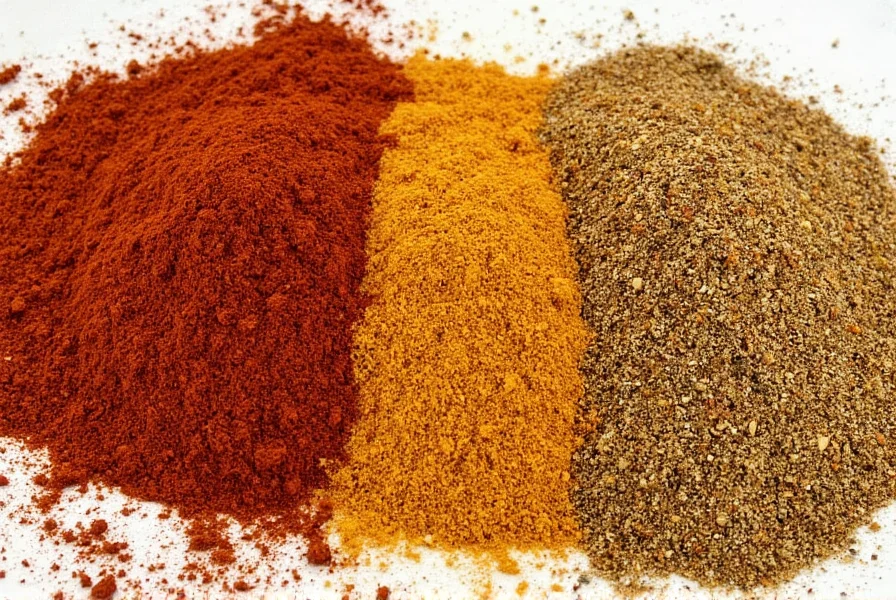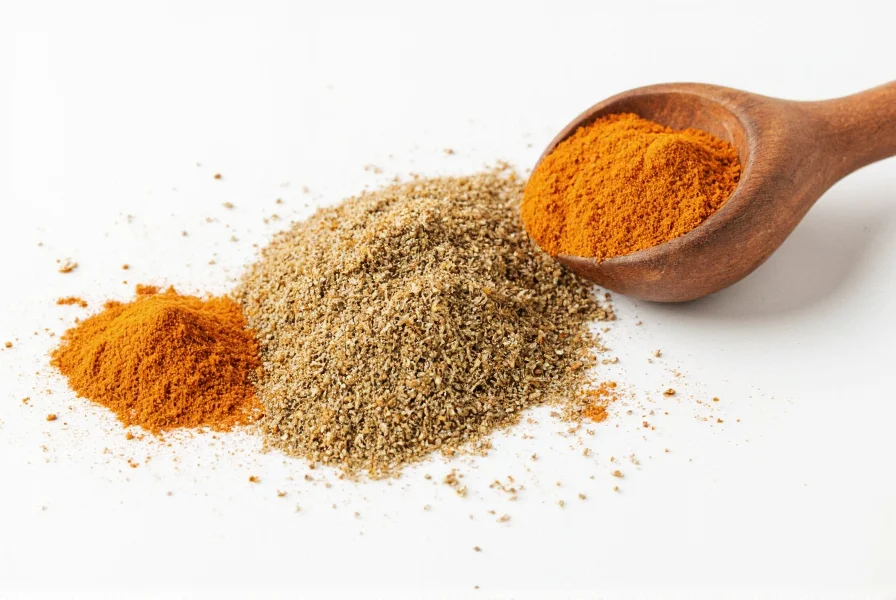If you've ever reached for cumin only to find your spice jar empty, you're not alone. This earthy, warm spice is essential in many global cuisines, from Mexican to Indian to Middle Eastern dishes. Understanding cumin substitutes requires knowing what makes cumin unique—its distinctive earthy, slightly citrusy flavor with warm undertones and subtle smokiness. When selecting a replacement, consider both the flavor profile you're trying to achieve and the specific dish you're preparing.
Understanding Cumin's Flavor Profile
Cumin brings a complex flavor that's simultaneously earthy, warm, slightly bitter, and citrusy with a hint of smokiness. It's a foundational spice in many spice blends and standalone recipes. When seeking cumin alternatives, you'll need to consider which aspects of cumin's flavor are most important for your particular dish. For instance, in chili recipes, the earthiness matters most, while in Indian curries, the warm citrus notes might be more critical.

Top 7 Cumin Substitutes Ranked by Effectiveness
1. Chili Powder (Best for Mexican and Southwestern Dishes)
Chili powder makes an excellent cumin substitute in chili, tacos, and other Southwestern dishes. While commercial chili powder blends already contain cumin (typically 25-30%), they provide a similar earthy profile with added heat from cayenne and other chilies. Use 1.5 teaspoons of chili powder for every 1 teaspoon of cumin required. This cumin replacement works particularly well when you need a substitute for cumin in chili recipes where additional heat complements the dish.
2. Garam Masala (Ideal for Indian and Middle Eastern Recipes)
Garam masala contains cumin along with other warm spices like cardamom, cloves, and cinnamon. Use equal parts garam masala to replace cumin in curries, stews, and rice dishes. The flavor will be more complex and slightly sweeter than pure cumin, but it maintains the essential warmth that cumin provides. This substitute shines when you need a cumin alternative for Indian recipes where the additional spices enhance rather than detract from the dish.
3. Coriander and Paprika Blend (Most Versatile All-Purpose Substitute)
Combine equal parts ground coriander and paprika to create a balanced cumin replacement. Coriander provides the citrus notes while paprika contributes earthiness. Use this 1:1 substitute in most applications, from soups to roasted vegetables. For a smokier profile similar to toasted cumin seeds, use smoked paprika instead of regular paprika. This combination works exceptionally well as a cumin substitute for Mexican food where smokiness is desirable.
4. Curry Powder (Excellent for Stews and Braises)
Curry powder typically contains 20-25% cumin along with turmeric, coriander, and other spices. Substitute curry powder at a 1:1 ratio when making stews, braises, or hearty vegetable dishes. The resulting flavor will be more complex and yellow-hued due to the turmeric, but it maintains cumin's essential warmth. This works best when you need a replacement for ground cumin in recipes where color isn't critical.
5. Caraway Seeds (Specialty Substitute for European Dishes)
Caraway shares cumin's earthy, slightly citrus profile but with more pronounced anise notes. Use half the amount of caraway seeds compared to cumin, as they're more potent. This substitute works particularly well in German, Austrian, and Eastern European dishes where cumin sometimes appears. However, avoid using caraway as a cumin substitute in Mexican or Indian recipes as the flavor profile diverges significantly.
6. Taco Seasoning (Convenient Pantry Option)
Most commercial taco seasonings contain 15-20% cumin along with other complementary spices. Use 1.5x the amount of taco seasoning to replace cumin in Mexican dishes. This substitute works well when you need a quick cumin replacement for taco night but will add additional salt and other flavors to your dish. For best results, choose a low-sodium version to maintain control over your recipe's seasoning.
7. Fennel Seeds (Niche Substitute for Specific Applications)
Fennel seeds offer a mild, slightly sweet alternative with subtle earthiness. Use half the amount of fennel seeds compared to cumin, as they're more potent. This substitute works best in Mediterranean dishes or when making sausage blends where cumin occasionally appears. Avoid using fennel as a cumin substitute in recipes requiring strong earthy notes, as it simply doesn't provide the same depth.
Cumin Substitution Ratio Guide
| Substitute | Ratio to Replace 1 tsp Cumin | Best For | Flavor Difference |
|---|---|---|---|
| Chili Powder | 1½ tsp | Mexican dishes, chili | More heat, less earthiness |
| Garam Masala | 1 tsp | Indian curries, rice dishes | Sweeter, more complex |
| Coriander + Paprika (1:1) | 1 tsp total (½+½) | All-purpose cooking | Less smoky, brighter |
| Curry Powder | 1 tsp | Stews, braises | More complex, yellow hue |
| Caraway Seeds | ½ tsp | European dishes | More anise notes |
Substitutes to Avoid
Some spices commonly suggested as cumin alternatives simply don't work well. Avoid using cumin substitutes like:
- Cinnamon (too sweet, lacks earthiness)
- Nutmeg (overpowering, wrong flavor profile)
- Cumin extract (not a practical substitute for most home cooks)
- Ground cloves (too strong, completely different flavor)
Choosing the Right Substitute by Cuisine
The best cumin replacement depends heavily on what you're cooking:
- Mexican dishes: Chili powder or coriander-paprika blend work best as cumin substitutes for Mexican food
- Indian recipes: Garam masala or curry powder make the most authentic cumin alternative for Indian recipes
- Middle Eastern dishes: Coriander-paprika blend or small amounts of caraway
- Mediterranean cooking: Fennel seeds or coriander alone
- General cooking: The coriander-paprika combination serves as the most versatile cumin replacement ratios

Pro Tips for Successful Substitution
When substituting for cumin, follow these professional cooking techniques:
- Add substitutes later in the cooking process than you would cumin, as many alternatives have more delicate flavors
- Start with 75% of the recommended amount, then adjust to taste
- For recipes calling for whole cumin seeds, toast your substitute spices briefly to enhance flavor
- Combine two substitutes (like coriander and a pinch of cayenne) for more complex replacements
- When using blends like chili powder or garam masala, reduce other seasonings accordingly
When Substitution Isn't Enough
For dishes where cumin is the star flavor (like certain Indian breads or specific Middle Eastern dips), substitutes may not provide satisfactory results. In these cases, consider these alternatives:
- Make a quick trip to the store—cumin is widely available and relatively inexpensive
- Borrow from a neighbor if it's an emergency
- Temporarily modify the recipe to feature a different spice profile entirely
- Order cumin online for future emergencies (many grocery delivery services offer same-day delivery)
Frequently Asked Questions
Can I use paprika instead of cumin in chili?
Yes, but with adjustments. Use equal parts paprika to replace cumin, but add a pinch of coriander to replicate cumin's citrus notes. For better results, use smoked paprika which provides the earthiness closer to cumin. Remember that paprika alone lacks cumin's distinctive warmth, so you may need to increase other spices like oregano or garlic to compensate.
What's the best cumin substitute for someone with a cumin allergy?
For those with cumin allergies, the safest substitutes are coriander combined with a small amount of chili powder or smoked paprika. Avoid caraway if you have Apiaceae family allergies, as it's related to cumin. Always check ingredient labels carefully, as many spice blends contain hidden cumin. The coriander-paprika combination provides the most similar flavor profile without cross-reactivity concerns for most people with cumin allergies.
How do I substitute cumin in hummus?
For hummus, the best cumin substitute is a combination of coriander and a tiny pinch of smoked paprika (about ¼ tsp paprika to ¾ tsp coriander for each tsp of cumin). Tahini-based dishes like hummus rely on cumin's earthy notes, so this blend maintains the essential flavor profile. Alternatively, a small amount of ground sumac can provide the citrus notes that complement tahini well, though it won't replicate cumin's warmth.
Can I use cumin substitute in place of ground cumin for baking?
Cumin is rarely used in baking, but when it appears (as in some Middle Eastern breads), the best substitute is a combination of coriander and a tiny amount of fennel seed. Use half the amount you would for savory dishes, as baking requires more delicate spice handling. For sweet applications that mistakenly call for cumin (which is uncommon), consider whether the recipe might have meant another spice like cinnamon or cardamom instead.
What's the difference between using cumin substitutes in vegetarian versus meat dishes?
In meat dishes, you can often use stronger substitutes like caraway or higher amounts of chili powder, as the robust flavors of meat can handle more intense spices. For vegetarian dishes, use lighter-handed substitutions—reduce amounts by 25% and consider adding umami boosters like soy sauce or nutritional yeast to compensate for cumin's earthy depth. The best cumin substitute for lentil dishes, for example, would be a milder coriander-paprika blend compared to what you'd use in beef chili.











 浙公网安备
33010002000092号
浙公网安备
33010002000092号 浙B2-20120091-4
浙B2-20120091-4